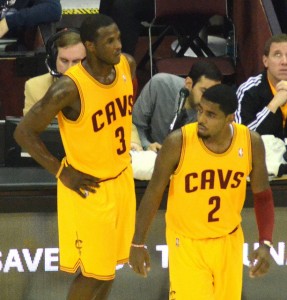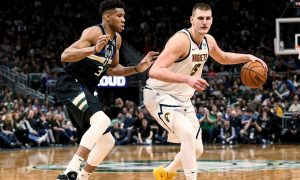
Image courtesy of Erik Daniel Drost/Flickr.
The NBA’s great debate of the moment is not the MVP race (although LeBron James versus Kevin Durant is an historically good one), or what Kobe Bryant has left in the tank (despite Bryant’s seemingly permanent place at the forefront of the basketball zeitgeist), or even the one-and-done rule (of particular importance every March). The rising emphasis on offseason activity and roster building has superseded these more traditional ESPN-fueled debates. No, the current discussion at the forefront of the modern NBA, the one that underlies all the others, can be captured in a word: tanking.
And the Cleveland Cavaliers belong at the center of that debate. The widely-adopted and supposedly fool-proof model of franchise rebuilding involves stripping a roster of its most expensive components, yielding valuable draft picks via weak outcomes in the win column, advantageously wielding cap room, producing a star player (either by drafting and grooming one, or swinging a trade), and ultimately reaping the rewards of that patience. It’s an approach that has been adopted by no fewer than eight NBA franchises in light of the new collective bargaining agreement. Its success is best exemplified by the thriving Oklahoma City Thunder and yet refuted by the dim prospects of several franchises, perhaps most notably the Cavaliers.
In defense of the Cavs, their adoption of the model was not a lazy concession and a willful teardown, but rather a forced development after the most traumatic event in the franchise’s history: the departure of LeBron James in the summer of 2010. The Cavs seemingly had every intention of retaining the world’s greatest player and carrying on its (very novel) tradition of winning, but down to Miami the King descended, and the Cavs were forced to start somewhere. I wrote last summer that this was a uniquely terrible situation, uncharted territory in NBA history. What was the team to do?
The Oklahoma City model seemed a clear enough path. After patching together a roster of holdovers (J.J. Hickson, Mo Williams, Antawn Jamison) and mostly low-cost, short-term deals (Christian Eyenga, Alonzo Gee), the Cavaliers traded for three years and $42 million of Baron Davis and, as compensation for their trouble, received a draft pick belonging to the Los Angeles Clippers. In what can only be described as karmic compensation for the James-related trauma, this became the unlikely first overall selection in the 2011 draft, and imitating Oklahoma City’s precedent suddenly became a very plausible and promising path for this downtrodden franchise. They went on to use the amnesty clause on Davis, swapped Hickson for a potentially-valuable future pick from the Sacramento Kings, and largely preserved their cap space, all in adherence to the sacred standards of tanking and rebuilding.
And yet nearly three years have passed and the Cavaliers are almost certainly lottery-bound once again. The summer of 2013 seemed an opportune time to spin some of their assets into a more capable roster, but the Cavaliers stayed patient, signing Andrew Bynum with unguaranteed money and continuing to groom the youngsters, including their second No. 1 draft selection in only three years, Anthony Bennett of UNLV. But their assets have only lost value since the start of the season (Bennett’s rookie season has been a bust, Tristan Thompson’s ceiling appears low, Dion Waiters is a problematic employee), Kyrie Irving’s rookie contract is winding down, and the window to meaningfully convert these rebuilding years into a tangible product is closing fast.
So when the Cavaliers were accused of mortgaging their future only to miss the playoffs yet again in their mid-season trade for Luol Deng, a deal in which the Cavs sent Bynum and three draft picks to the Chicago Bulls, and one that has paid no immediate dividends for the franchise, the debate seemed misguided. Because what future, exactly, were the Cavaliers mortgaging? The team has had four opportunities to bring bona fide prospects into their system in the last three drafts, and only Irving appears to be capable of even making an All-Star team, let alone contributing to a championship contender. Draft-day hindsight is always a silly exercise, but for the sake of argument, the Cavs could theoretically be fielding a core of Irving, Klay Thompson, Andre Drummond, and Victor Oladipo. Instead it’s Bennett, Thompson, and Waiters, none of whom can field much of anything in a trade, let alone contribute meaningfully to a winning team. If the Cavs shed a few conditional picks for half a season of Deng, what are they losing, exactly?
This hardly reads like a bold defense of the move, because it isn’t. But draft picks are only valuable if a team can convert them into meaningful contributors, via successful scouting and talent development. The Cavaliers have largely failed in both arenas, and are as well off turning those assets into a sure thing as they would have been holding on to them. The Deng deal was far from perfect, but something had to give eventually.
The one way out for this franchise, well-reported and anticipated elsewhere, is the return of LeBron James during one of the following three summers, any of which he might choose to become a free agent. If it seems wildly far-fetched that the world’s greatest player would leave Miami for Cleveland, that’s because it almost certainly is. But the city of Cleveland is far from an ideal free-agent destination, James’ connection to Cleveland spans the course of his life, and the franchise has made perfectly clear it’s unable to draft productively. What course of action remains?
The Cavs are about as close as you can come to a lost cause: they had the world’s greatest player but couldn’t retain him, were then bestowed a golden opportunity to reorganize quickly, but have badly faltered. Swapping some conditional picks for Luol Deng wasn’t the landscape-altering fiasco some pundits have declared it, but it isn’t solving any problems, either. There are just much bigger issues at play for the Cavaliers.














